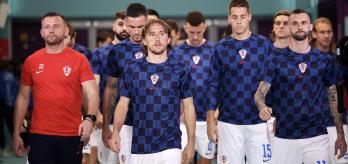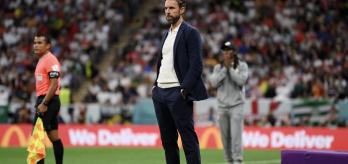00:06
The standard of goalkeeping at the FIFA World Cup Qatar 2022™
Zuberbühler briefly discusses the versatility and development of modern-day goalkeepers, before focussing specifically on the Number 1s of the four World Cup semi-finalists: Croatia’s Dominik Livaković and France’s Hugo Lloris, who produced some terrific saves throughout the tournament; Yassine Bounou of Morocco, who shone in a compact system alongside his defenders; and Argentina’s Emiliano Martínez, whose terrific performances, most notably in the final, were key to Argentina’s success. FIFA’s goalkeeping expert also shares his general praise for the goalkeepers at Qatar 2022, highlighting their ability to pass the ball and make crucial saves, among other things.
01:50
The tendency for goalkeepers to occupy more advanced positions
In the 90s, goalkeepers were mere shot-stoppers, confined to their six-yard box. However, modern-day keepers are mostly intent on attacking the ball, occupying positions on the edge of the penalty area, or even outside it. High defensive lines have also driven goalkeepers into more advanced positions to maintain the close connection between themselves and their defenders, reassuring the latter of their excellent position to intercept balls played over the top. Zuberbühler also mentions the importance of goalkeepers knowing when to act as an extra player (“sweeper-keeper”) and how to adjust their body position to cover spaces, for example.
06:02
What playing in a mid-block means for goalkeepers
Modern-day keepers work more closely with outfield players in training, better preparing them for a mid-block system — a prominent trend at Qatar 2022. To fit into this system, goalkeepers must be comfortable playing with their feet and able to adjust their position quickly when their team loses possession, staying high up the pitch and close to their defensive line. A great example of this from the World Cup is Yassine Bounou, who would often clear the danger posed by long balls while defending the zone in behind his defence, and who would also take up more central positions to defend his goal and assess the in-game situation accordingly.
08:25
How to save penalties under the new rules and adapt as a goalkeeper from a poor starting position
Zuberbühler alludes to the new penalty rules, explaining how Emiliano Martínez takes an ideal approach to saving spot-kicks in the modern era by stepping off his line as he does. FIFA’s goalkeeping expert also refers to the Argentine’s save from Randal Kolo Muani in the 123rd minute of the World Cup final, for which he started from a very deep position, far behind his defensive line as the ball came over the top following a defensive mistake. To recover, the Aston Villa keeper held his ground just outside the six-yard box, standing tall in an X-block position that allowed him to get down low to block the ball with his left leg.
10:08
The importance of goalkeepers offering to receive the ball
While the primary function of a modern-day goalkeeper is still to make saves, Zuberbühler explains that keepers offered to receive the ball almost twice as much at the 2022 World Cup than at Russia 2018™. Keepers will now play much closer to their defenders, asking to receive the ball in certain areas, before controlling it and playing it out. Jordan Pickford is a perfect example, who effectively joins England’s centre-backs to form a back three when they are building up from the back and the two full-backs have pushed on. This means that goalkeepers must work more closely with their team-mates in training to become more comfortable playing with their feet.
14:04
The need for defenders to know where their goalkeeper will be
Defenders must know where their goalkeeper will be in any in-game situation, whether they are holding a high line or sitting in a mid-block. For instance, Dominik Livaković is the perfect example of a goalkeeper who operates well in a deeper system, for a Croatia side that relies heavily on counter-attacks and fast transitions. Meanwhile, Unai Simón is key to Spain’s possession-based system, standing almost equidistant to his penalty area and the halfway line when his team are in possession in the final third. This allows him to intercept balls played beyond his team’s high defensive line, or to play out to his centre-backs or full-backs when Spain are building up from the back.
16:22
The need for variable distribution
However, if a goalkeeper always goes short to their defenders and midfielders in a possession-based team, like Simón, this tactic starts to become risky as the opposing forwards grow accustomed to it. That is why variable distribution is so important, creating a degree of unpredictability. For example, the goalkeeper could play the ball long to their centre-forward, who could hold it up and bring their teammates into play, rather than constantly playing the ball out to their centre-backs, full-backs or midfielders. Therefore, the head coach must liaise with the goalkeeping coach to find the most suitable goalkeeper for the team’s system.
18:40
Decision-making as a goalkeeper
Goalkeepers must also be good decision-makers. For instance, if their defence holds a high line and the ball is played over the top, a keeper must decide whether to attack the ball or transfer the responsibility onto the closest defender if they drop back — an understanding that develops in training by working together with their team-mates. Similarly, goalkeepers can receive the ball from their defenders on the other side of the penalty area, evading the onrushing press and opening up the other side of the pitch, or hold their position when the ball is played through and the opposing striker is only slightly ahead of their last defender.













